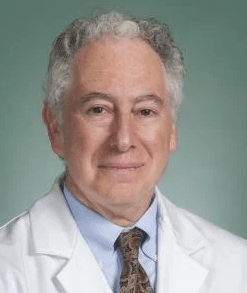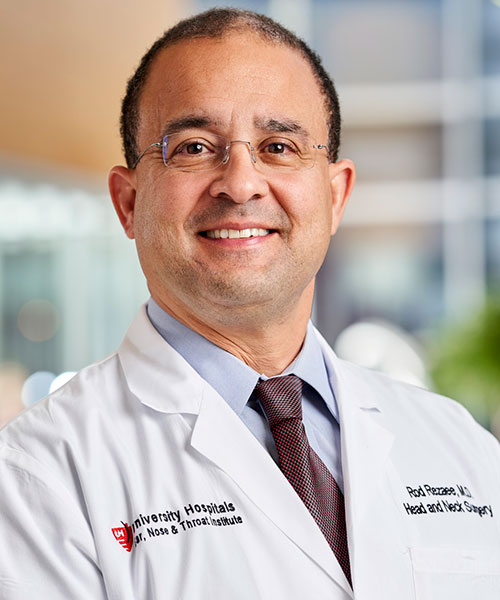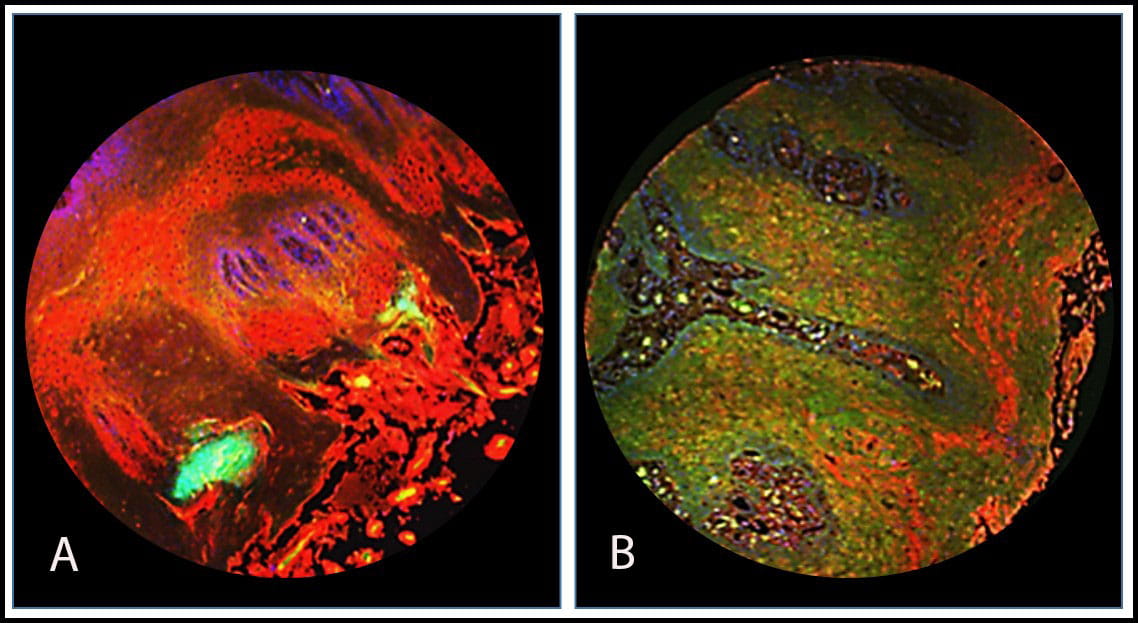Multicenter Research Team Discovers Novel Method to Test for Oral Cancer
August 06, 2024
Innovations in Ear, Nose & Throat | Summer 2024
The University Hospitals Ear, Nose & Throat Institute is collaborating with Case Western Reserve University School of Dental Medicine on a noninvasive, low-cost test to detect oral squamous cell carcinoma (OSCC) and monitor precancerous lesions.
 Aaron Weinberg, DMD, PhD
Aaron Weinberg, DMD, PhD Rod Rezaee, MD
Rod Rezaee, MDAdditional sites include the University of Cincinnati Medical Center and West Virginia University School of Dentistry. Cell Reports Medicine published the team’s findings in March 2024.
Co-Principal Investigator Aaron Weinberg, DMD, PhD, explains the discovery that led to the novel testing platform: “We observed that changes in the ratio between two proteins, human beta-defensin 3 and 2 [hBD-3 and hBD-2], accompanied the carcinoma in situ phenotype. In the early stages of tumorigenesis, hBD-3 is overexpressed compared to hBD-2.”
Scrapings of lesion cells were collected from consenting patients and compared to contralateral normal cells using a scoring tool called the beta-defensin index (BDI). The blinded validation study demonstrated sensitivity and specificity of 98 percent and 83 percent.
A Newly Discovered Protein Duality
An antimicrobial peptide expressed in epithelial cells, hBD-3 contributes to a healthy immune response and wound healing. “If we burn our tongue or bite our cheek, this particular protein protects the wound from microbial challenges and stimulates the proliferation of epithelial cells to close it,” says Dr. Weinberg, Chair and Professor of the Department of Biological Sciences at the School of Dental Medicine and a member of the Population and Cancer Prevention Program at Case Comprehensive Cancer Center. “However, we have shown that hBD-3 also promotes tumor growth where the mechanism for epithelial cell proliferation gets hijacked, revealing a Dr. Jekyll and Mr. Hyde duality.”
 An immunofluorescent picture of a normal tongue compared with stage two tongue cancer. The healthy tongue tissue (A) is stained red by a fluorescent antibody to hBD-2 (the good protein). The cancerous tongue tissue (B) stained green because of overexpression of the protein indicating cancer (fluorescent antibody to hBD-3).
An immunofluorescent picture of a normal tongue compared with stage two tongue cancer. The healthy tongue tissue (A) is stained red by a fluorescent antibody to hBD-2 (the good protein). The cancerous tongue tissue (B) stained green because of overexpression of the protein indicating cancer (fluorescent antibody to hBD-3).The current gold standard test for a suspicious mouth lesion is biopsy, but “greater than 95 percent of biopsy results are negative,” Dr. Weinberg says. “Imagine if we had a tool to assist the clinician in determining who needs more invasive testing?” In addition to sparing patients an uncomfortable procedure, there is tremendous potential for better resource utilization. The cost for the test is a few dollars, compared higher costs for traditional biopsy and pathology review.
Meeting a Clinical Need
OSCC accounts for approximately 90 percent of malignant tumors of the head and neck. Often associated with lifestyle factors, including tobacco, alcohol and betel nut overconsumption, OSCC lesions develop in the mucosal surfaces of the oral cavity and can be difficult to diagnose accurately. Early detection of oral cancer is associated with less invasive treatment and higher survival.
“Effective screening needs to be cost-effective and reliable,” says Co-Principal Investigator Rod Rezaee, MD, Director of Head and Neck Surgical Oncology and Reconstruction at the UH ENT Institute, Co-Director of the Head and Neck Oncology Disease Team at University Hospitals Seidman Cancer Center and Professor of Otolaryngology at Case Western Reserve University School of Medicine. “Dr. Weinberg’s project is moving us toward a tool that is able to be disseminated not just locally but nationally and internationally.”
Expanding to a Global Population
The team recently submitted a multimillion-dollar grant to the National Cancer Institute to conduct a large and demographically diverse study, including three U.S. sites and one in the United Kingdom.
“Expanding our patient base will permit us to validate the early detection platform with a much larger population, many of whom have unique risk factors,” Dr. Weinberg says. “We are collaborating with Queen Mary’s Hospital in East London, where there are many refugees from countries where smoking and betel nut practice is widespread.”
The seed of the areca catechu tree, betel nut contains a psychoactive compound called arecoline that has been used for centuries as a stimulant. Arecoline is a member of the nicotine family, and people who use it chronically often develop lesions in their oral cavity.
“It is a major problem in India, where oral cancer is the number one cancer in men and number three in women,” Dr. Weinberg says. “We hope this test will be beneficial in parts of the world where pathology review may be less accessible and/or imprecise.”
Next Steps
Researchers are working to develop a point-of-care device that will provide accurate results at chairside. “We are collaborating with biomedical engineers here at CWRU to generate a prototype that will be analytically tested,” Dr. Weinberg says. “Instead of a 16- to 24-hour turnaround, clinicians could share results with patients in 15 to 30 minutes.”
Dr. Weinberg and the team also are studying the potential translation to other types of squamous cell carcinomas.
“Discovery on this level only works when everyone shares in the mission, and this project is emblematic of that,” Dr. Rezaee says. “Before I became involved, Dr. Chad Zender worked with Dr. Weinberg in a longstanding, collaborative partnership prior to his transition to UC Health in Cincinnati. We have continued that partnership with UC, facilitating the multi-institutional nature of the project. Ultimately, our collective goal is to make it easier for people to have access to this screening tool and improve patient outcomes.”
For more information, contact Dr. Weinberg at 216-368-6729 or Dr. Rezaee at 216-998-4427.
Contributing Experts:
Aaron Weinberg, DMD, PhD
Chair and Professor
Department of Biological Sciences
Case Western Reserve University School of Dental Medicine
Professor
Department of Otolaryngology
Department of Pathology
Case Western Reserve University School of Medicine
Member, Population and Cancer Prevention Program
Case Comprehensive Cancer Center
Rod Rezaee, MD
Director, Head and Neck Surgical Oncology and Reconstruction
University Hospitals ENT Institute
Co-Director, Head and Neck Oncology Disease Team
University Hospitals Seidman Cancer Center
University Hospitals Cleveland Medical Center
Professor of Otolaryngology
Case Western Reserve University School of Medicine


